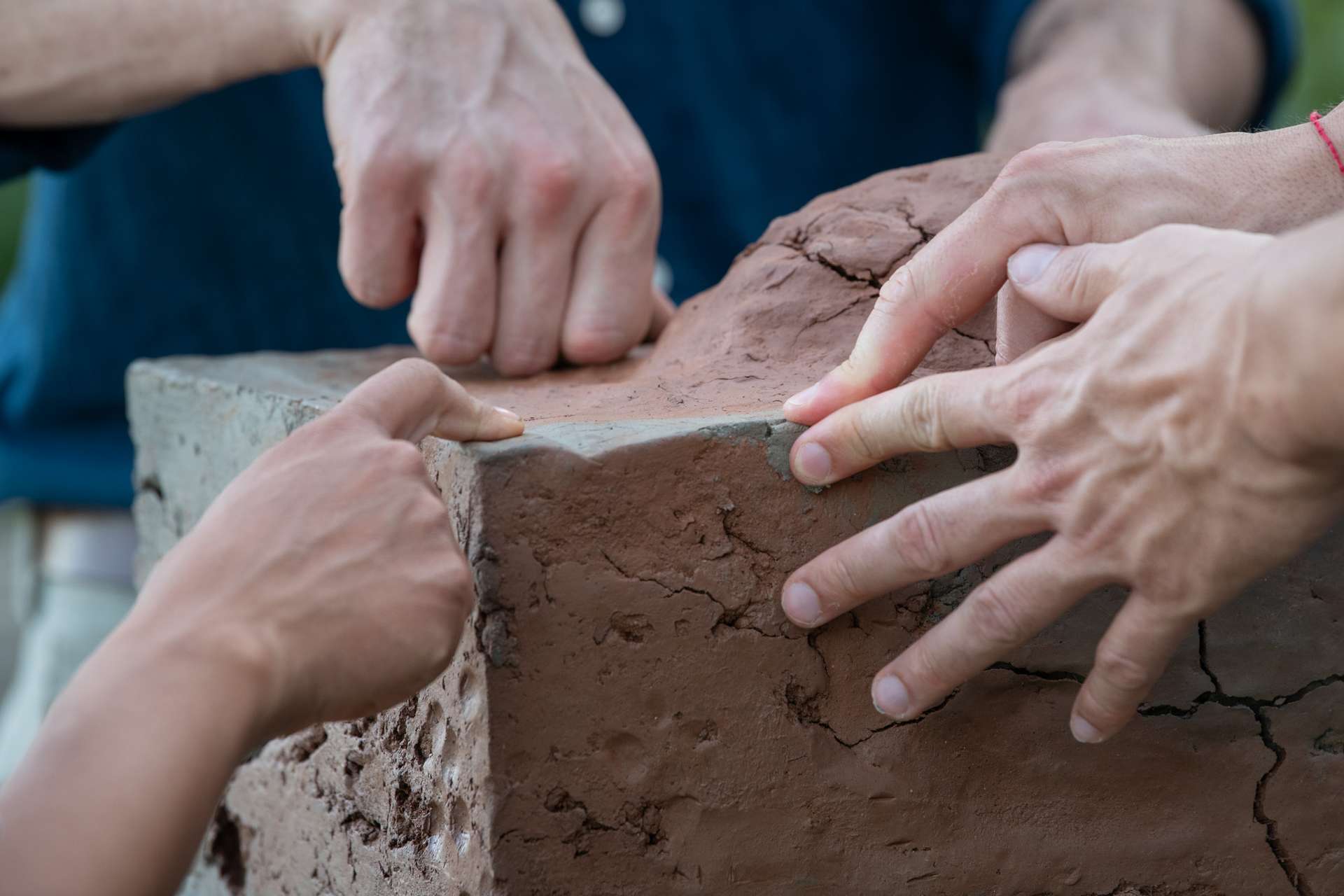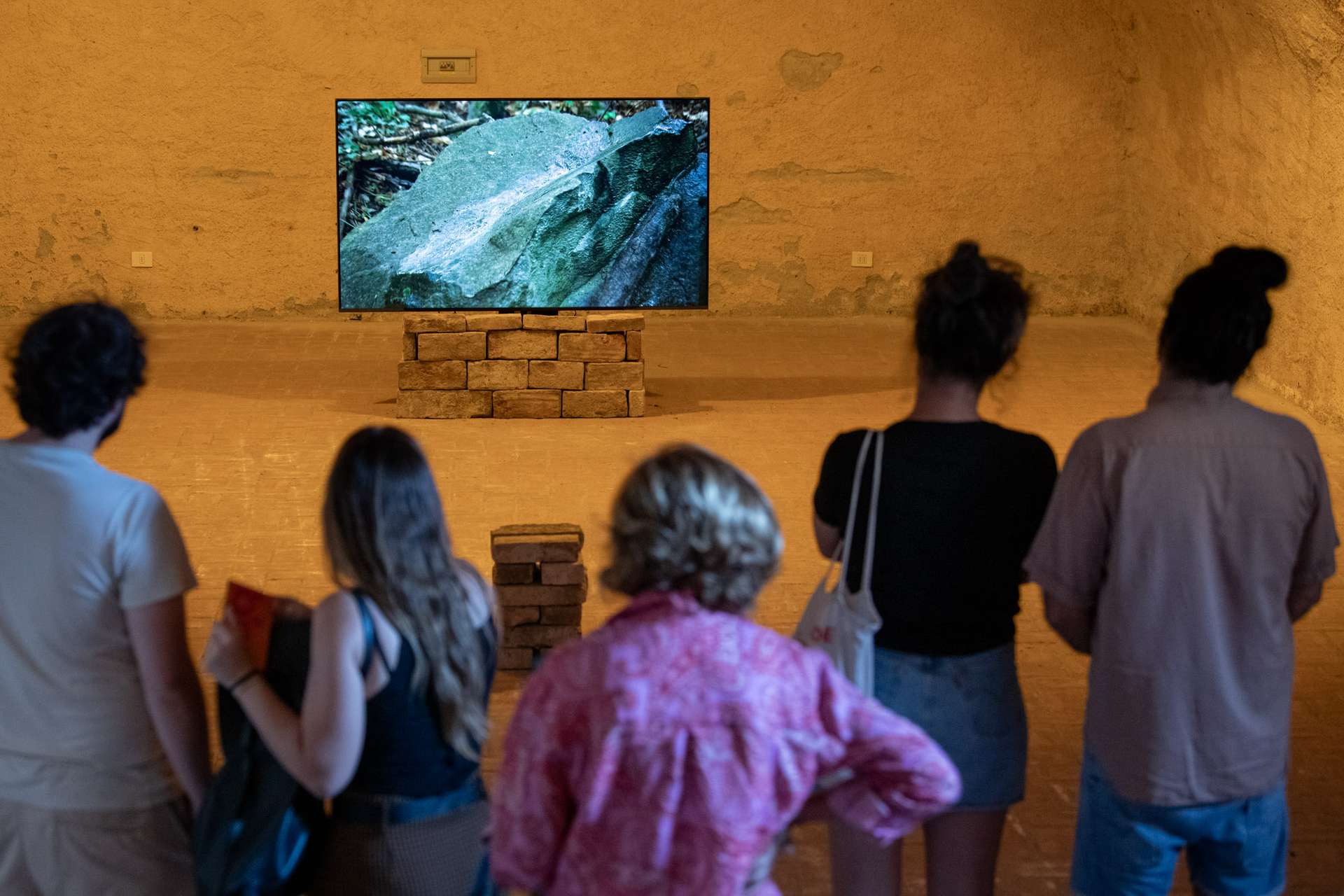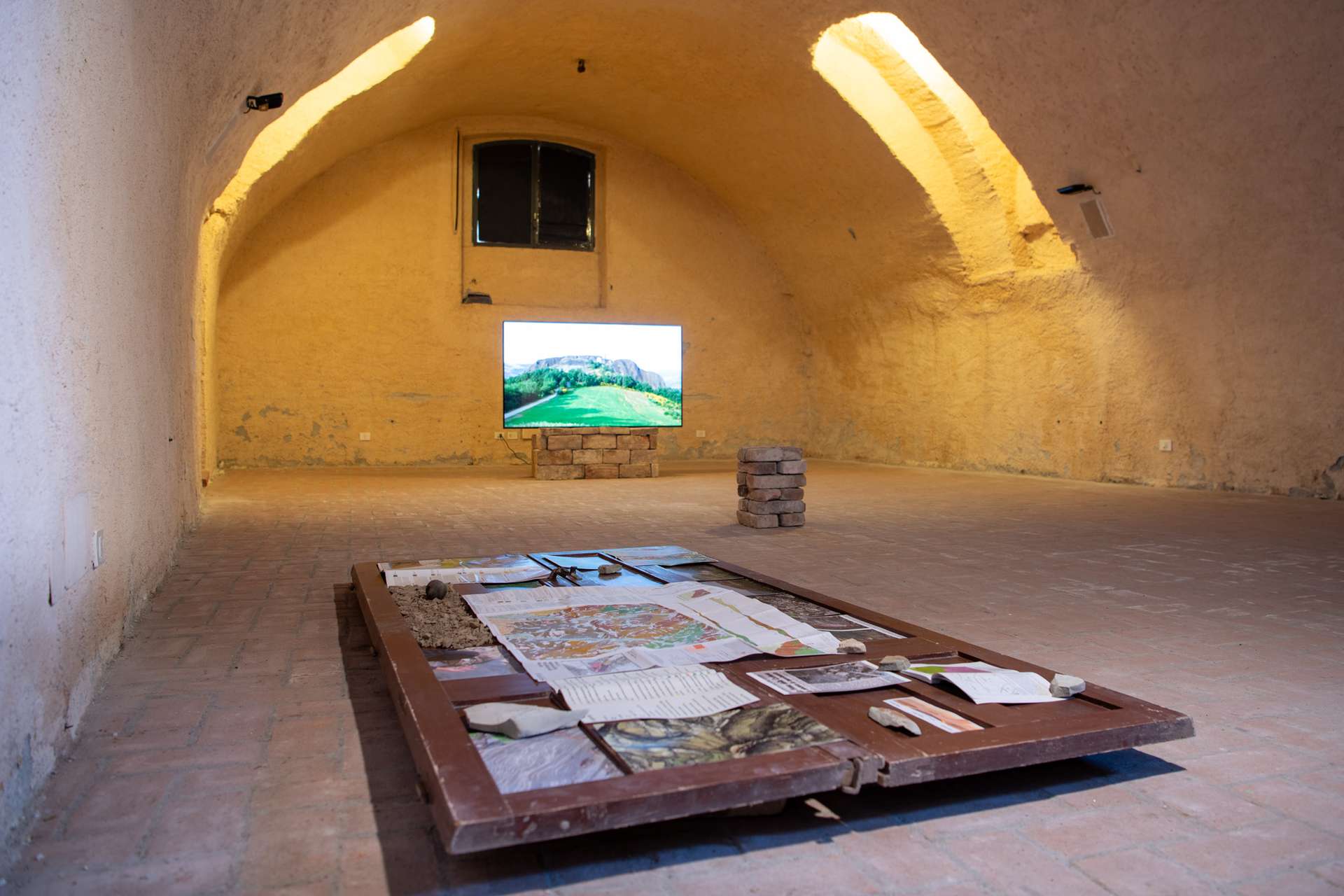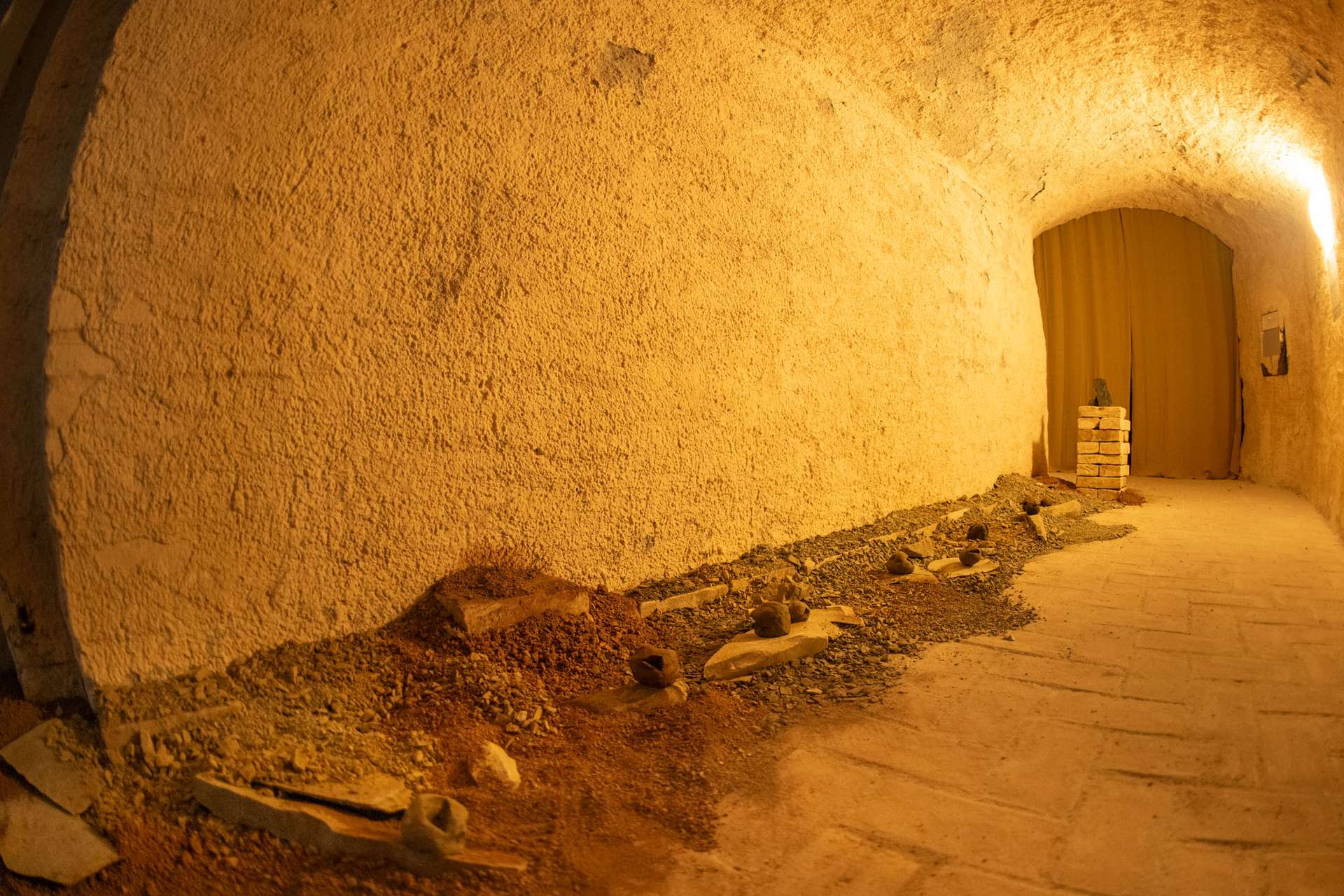Palestinian artist and architect Raghad Saqfalhai presents La montagna è ancora in movimento (The mountain is still moving) - لايزالُ الجبلُ يتحرّك , a project that shows attention both to the stories of the inhabitants of Travo and to the area’s millenary geological history. This new stage of the long-term project The Geography of Craft, which began in Jerusalem in 2021, merges the material landscape flowing beneath our feet with the symbolic landscape of popular imagination.
The sculptures are made from materials of different hardness, from the plasticity of clay to the solidity of marl, while the final appearance evokes the original image of the mountains Pietra Perduca and Pietra Parcellara. The visual loneliness of these two rocky peaks is a fairly recent occurrence; the rain gradually dissolved the layer of clay that enveloped their profile and the crags were left standing alone in a green landscape. The generative evolution of the sculptures is reminiscent of the geological process in the creation of layers and the slow accumulation brought by the elements.
After consulting local archives and performing a series of interviews, the artist made a video mapping the affections of the inhabitants of Travo, based on the conviction that landscape and community are symbiotic organisms, capable of influencing one another. The sculptural series was placed in the territory of Travo, with the aim of exploring the concept of the village, which goes beyond the limits of the historic centre and spreads to neighbouring areas, often forgotten but essential to the residents’ material and symbolic economy. The artist therefore donated a Sentiero d’Artista (Artist’s Path) to the community of Travo, a physical and mental itinerary to discover the works in the area, an aesthetic device for re-appropriating spaces and times dedicated solely to perception and attention. Saqfalhait’s works move on different temporal scales, on the threshold between the millenary geological dimension, the archaeological dimension that was a feature of the area from the earliest Neolithic settlements, to the more recent dimension of the stories of all those who have decided never to leave Travo.
ㅤ
ㅤㅤ
Exhibited works:
01. Raghad Saqfalhait, La montagna è ancora in movimento, 2023. Hand mold of various colored clay, marl, ophiolites, lime, wool and latex, variable dimensions.
The work created for the bank of the river Trebbia, by its nature perishable because it is made of raw clay, was absorbed by the surrounding landscape.
Bank of the river Trebbia, Travo
Not easily accessible to people with disabilities
ㅤ
02. Raghad Saqfalhait, La montagna è ancora in movimento, 2023. Excavation, treaded glass, lighting, variable dimensions.
Teatro Organico Perduca, site Termine Grosso, Travo
Outdoor theatre. Not easily accessible to people with disabilities
ㅤ
Permanent works:
01. Raghad Saqfalhait, La montagna è ancora in movimento, 2023. Hand mold of various colored clay, marl, ophiolites, lime, wool and latex, variable dimensions.
Cantine del Castello Anguissola, Piazza Trieste 16, Travo
ㅤㅤ
02. Raghad Saqfalhait, La montagna è ancora in movimento, 2023. Personal archives, in situ explorations, oral testimonies, aerial maps and geological studies, video 20:54 min approx.
Cantine del Castello Anguissola, Piazza Trieste 16, Travo
I CAN FEEL THE WATER MOVING INSIDE THE MOUNTAIN BENEATH MY FEET, BUT I CANNOT SEE IT. THE WATER CREATES PATHWAYS BETWEEN THE CRACKS IN THE CLAY SOILS THAT ENVELOP THE OPHIOLITES. ON THE MICRO-SCALE, THE WATER BREAKS UP THE CLAY SLABS, DISPERSING THEM, PUSHING THEM APART AND SWELLING THEM. THE WATER EVAPORATES, THE CLAY SHRINKS, THE TERRAIN CRACKS, THE MOUNTAIN IS STILL MOVING
Raghad Saqfalhait was born in Ramallah, Palestine, in 1996. She is an artist and an architect working in the multi-disciplinary field of material research and design. She documents and experiments with material, their histories of extraction and transformation, their geological structures and compositions, and their entanglement with questions of property and exploitation within geographies of settler colonialism.
Her work was supported by The Prince Claus Seed Awards 2022 and was part of Riwaq’s research/ artistic project The Absent Map: Rural Jerusalem in an Alternative Narrative. She received the JEA prize for her project Scales of Integration: The Body, the Cemetery, and the Terrain.
She started her long-term project The Geography of Craft in 2021 in Al-Jib, Jerusalem and then expanded to other rural contexts like Cutrofiano, Puglia, during Soil Futures residency at KORA - Contemporary Arts Center with Art Vessel. In that framework, she conducted multiple hands-on workshops and installations over the past two years such as La Crita è mia! On Material and Materiality in Cutrofiano, Wild Clay Lab in Al-Jib, and Molding with Waste in Ramallah.
In 2019, she co-founded Sakeb: a design collective working on, about, and through waste; especially waste produced by the Stone and Marble Industry in Palestine. Sakeb was exhibited in multiple venues including Milan Design Week (2022), Amman design Week (2019), Warehouse421, Art Jameel, Khalil Sakakini Cultural Center, Beit Obaid Al-Shamsim A.M. Qattan Foundation.
THE INTERVENTION IS INSPIRED AS MUCH BY THE TALES OF THE INHABITANTS OF THE VILLAGE AS BY ITS MILLENARY GEOLOGICAL HISTORY, ON A JOURNEY OF DISCOVERY OF WORKS IN THE AREA: A SERIES OF SCULPTURES MADE FROM MATERIALS OF VARYING DURABILITY AND A VIDEO CONCEIVED AS AN AFFECTIVE MAPPING OF THE INHABITANTS THEMSELVES
The village of Travo, which today numbers just over 2,000 inhabitants, has a history stretching back thousands of years: from the distant Neolithic period dating back to the fifth millennium B.C. to the arrival of the Ancient Romans, from the Longobard invasion to feudalism and on to the dominations by the various families in the area. The Archaeological Park of the Neolithic village of Travo, created in 2006 and enlarged with full-scale reconstructions of buildings, protects and promotes one of the most important prehistoric sites identified in northern Italy, where archaeological excavations are still being organised.
In the village, the Castle of Travo is a dominant presence, built by the Malaspina family in the 12th century and then taken over by the Anguissola family. Donated to the municipality in 1978, it now houses the Civic Archaeological Museum. For years it was the summer home of Giana Anguissola, an important 20th-century writer from Piacenza, to whom the National Literary Competition of unpublished novels and short stories for children, founded in 2010, is dedicated. The variety of cultural proposals in Travo is part of a precise strategy that also includes the promotion of its architectural and environmental heritage. In fact, Travo is a centre of primary importance in the province and especially in the Trebbia Valley, with thousands of tourists arriving in the summer.







